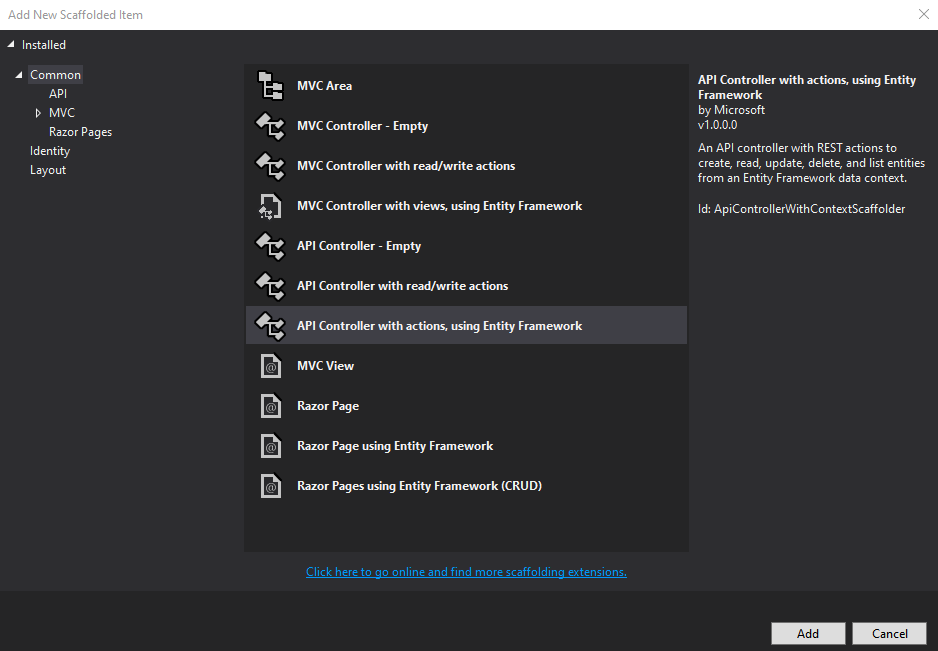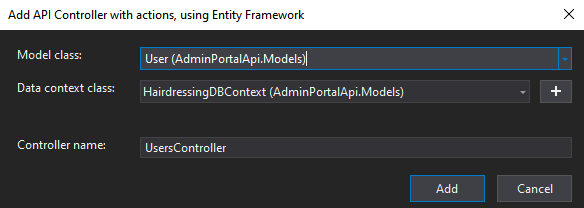Requirements
- .NET Core 3.1 SDK or later. How to install
- MySql server (preferrably v8.0.19 or later) running with the database and tables already created
The .NET Core CLI is included with the .NET Core SDK. To check that you have it installed, open a terminal and run:
dotnet --info
#Output
.NET Core SDK (reflecting any global.json):
Version: 3.1.200
...
1. Create a aspnet core web api
cd to your proyect directory and then run:
dotnet new webapi -o AdminApi
2. Install Packages
cd AdminApi
dotnet add package Microsoft.EntityFrameworkCore.SqlServer
dotnet add package Pomelo.EntityFrameworkCore.MySql
dotnet add package Microsoft.EntityFrameworkCore.Design
dotnet add package Microsoft.VisualStudio.Web.CodeGeneration.Design
3. Install tools
Entity Framework Core
Entity Framework (EF) Core is a lightweight, extensible, open source and cross-platform version of the popular Entity Framework data access technology.
EF Core can serve as an object-relational mapper (O/RM), enabling developers to work with a database using .NET objects, and eliminating the need for most of the data-access code they usually need to write.
dotnet ef must be installed as a global or local tool. Most developers will install dotnet ef as a global tool with the following command:
dotnet tool install --global dotnet-ef
dotnet aspnet-codegenerator
dotnet aspnet-codegenerator -runs the ASP.NET Core scaffolding engine. dotnet aspnet-codegenerator is only required to scaffold from the command line, it’s not needed to use scaffolding with Visual Studio.
dotnet tool install --global dotnet-aspnet-codegenerator
4. Reverse Engineering (Scaffolding) the database
We are going to use the dotnet ef dbcontext scaffold command to generate a Model and a database context from our existing database.
dotnet ef dbcontext scaffold "Server=localhost;Database=hair_project_db;User=dev_admin;Password=administrator;TreatTinyAsBoolean=true;" "Pomelo.EntityFrameworkCore.MySql" -o Models
This create the Models folder with all classes and the database context.
The DbContext is an important class in Entity Framework API. It is a bridge between your domain or entity classes and the database.
- The primary class that is responsible for interacting with data as objects DbContext.
- DbContext APIs simplify your application interaction with the database.
Configuration and User Secrets
5. Register the database context
Edit AdminApi/Startup.cs to register the database context
// ...
public void ConfigureServices(IServiceCollection services)
{
// Register DB Context
services.AddDbContext<hair_project_dbContext>(options =>
options
.UseMySql(Configuration.GetConnectionString("HairDesignDB"), mySqlOptions =>
mySqlOptions
.ServerVersion(new ServerVersion(new Version(5, 7, 24), ServerType.MySql))
));
services.AddControllers();
}
// ...
Edit AdminApi/appsettings.json and add:
"ConnectionStrings": {
"HairDesignDB": "Server=localhost;Database=hair_project_db;User=dev_admin;Password=administrator;"
}
6. Scaffold Controllers
Using dotnet aspnet-codegenerator command (terminal or Visual Studio Code terminal)
dotnet aspnet-codegenerator controller -name UsersController -async -api -m Users -dc hair_project_dbContext -outDir Controllers
dotnet aspnet-codegenerator controller -name UserFeaturesController -async -api -m UserFeatures -dc hair_project_dbContext -outDir Controllers
dotnet aspnet-codegenerator controller -name SkinTonesController -async -api -m SkinTones -dc hair_project_dbContext -outDir Controllers
dotnet aspnet-codegenerator controller -name SkinToneLinksController -async -api -m SkinToneLinks -dc hair_project_dbContext -outDir Controllers
dotnet aspnet-codegenerator controller -name HairStylesController -async -api -m HairStyles -dc hair_project_dbContext -outDir Controllers
dotnet aspnet-codegenerator controller -name HairStyleLinksController -async -api -m HairStyleLinks -dc hair_project_dbContext -outDir Controllers
dotnet aspnet-codegenerator controller -name HairLengthsController -async -api -m HairLengths -dc hair_project_dbContext -outDir Controllers
dotnet aspnet-codegenerator controller -name HairLengthLinksController -async -api -m HairLengthLinks -dc hair_project_dbContext -outDir Controllers
dotnet aspnet-codegenerator controller -name FaceShapesController -async -api -m FaceShapes -dc hair_project_dbContext -outDir Controllers
dotnet aspnet-codegenerator controller -name FaceShapeLinksController -async -api -m FaceShapeLinks -dc hair_project_dbContext -outDir Controllers
dotnet aspnet-codegenerator controller -name ColoursController -async -api -m Colours -dc hair_project_dbContext -outDir Controllers
- Right-click the Controllers folder.
- Select Add > New Scaffolded Item.
- Select API Controller with actions, using Entity Framework, and then select Add.
- In the Add API Controller with actions, using Entity Framework dialog:
- Select ClassName (AdminApi.Models) in the Model class.git
- Select TodoContext (TodoApi.Models) in the Data context class.
- Select Add.



7. Start the server
In a terminal, from the ../AdminApi/ directory, execute:
dotnet run